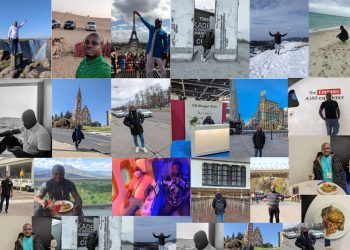Ghana is one country with a very storied past and chequered history having enjoyed both good and bad times. This storied past has left the country with dozens of historical sites where people, especially students could visit and get more insight into the history of Ghana and how far we have come as a nation.
Some of these historical sites date back to the era before the arrival of the Europeans in Ghana, some also date back to the Trans-Atlantic slave trade era when indigenes were being captured and shipped to Europe, and finally, the colonial era when the country, then known as Gold Coast was administered and ruled by the British.
Below are some of the historical sites in Ghana worth visiting:
Cape Coast Castle
History of the Cape Coast Castle dates back to the 16th century when the Portuguese traders arrived on the shores of Ghana and established a trading post on the shores of the Cape Coast sea in 1555. The shift from goods trading to human trading took off in roughly 1654 after the Swedes through a company known as the Swedish African Company had taken over the trading post and further developed it into a well-constructed timber fort with the intent of continuing the trading activities the Portuguese were into.
This however changed when the Swedes realized there was a huge demand for black slaves in the Americas and Europe. The Swedes then abandoned their plans to continue making the fort a trading post and instead converted it into a slave post where they kept captured slaves and shipped them to Europe and America. The fort later fell into the hands of the British who developed it into a complete castle to continue the slave-trading business.
Laranbanga Mosque
The Larabanga Mosque located in Larabanga, in the West Gonja District is one of the oldest mosques in Africa and the oldest in Ghana built in the year 1421. Originally the mosque was built with mud, reed and clay materials as that was the most popular building material at the time of its construction. However, in the 70s, cement materials were applied to its outer layer to give it more support and withstand the test of time. The biggest attraction at the mosque is an old Quran believed to have fallen from heaven to Imam Yidam Barimah in 1650.
Daboya Salt Mine
Over a half of the salt consumption of Ghana in the 1700s and 1800s was supplied by Daboya as a majority of the women and men in the town were engaged in the salt mining business, making it one of the most active and commercially vibrant towns in Ghana.
People from all walks of life especially northern and western Africa used to journey for miles just to come to Daboya and see this amazing town that was making history and prospering at an alarming rate. However, the salt business in Daboya collapsed in the mid of the 20th century when Ghanaians became more interested in granulated and iodised salt, putting Daboya out of business. Today these historical salt mines have become historical sites where thousands of people visit every year to learn more about the famous Daboya Salt Mines.
Kwame Nkrumah Mausoleum
The Kwame Nkrumah Mausoleum and Memorial Park was built on the old polo ground and dedicated to the first president of Ghana, Dr. Kwame Nkrumah in 1992. With a total land surface of 5.3 acres, the Kwame Nkrumah Mausoleum is the largest Historical Museum in Ghana. Just in front of the Mausoleum is the huge statue of Kwame Nkrumah, which can be seen from afar.
Some of the famous photographs found in the museum include Dr. Nkrumah’s pictures with Queen Elizabeth of England, Pope Pius XII, Fidel Castro, President Nasser of Egypt and John F. Kennedy of U.S.A.
Wa Naa’s Palace
Wa Naa’s Palace is among the oldest traditional palaces in Ghana built in the early part of the 19th century by the Wala people to serve as the royal home to the chief and his family as well as trusted and top officials of the chief. The Palace was built in ancient Sudanese mud-brick architectural style, giving credence to historical accounts that suggest that the Wala people, who today dominate the Upper West region, originally migrated from the northern part of Africa, precisely Sudan.
The structure sits comfortably in the heart of Wa as a major historical site that is visited regularly by tourists.
Ussher Fort
The Ussher Fort is an old historical site in Ghana, built in the year 1649 by the Dutch. The Fort which is located in Accra was originally known as Fort Crevecaur and was built by the Dutch to serve as a shelter for the Dutch traders who came to the Gold Coast to trade in the slave business which was booming at the time.
Built in 1642, the building served as a small factory until it was renovated and converted into a Fort in 1649 by the Dutch West Indian Company. While the Fort was not as imposing and important as the Osu and Elmina Castle, it played a great role in the pre-colonial trade between the indigenous people and the various European nations who all came to have control of the Fort at a point in history.
Nalerigu Defense Wall
The Nalerigu Defence Wall is located in Nalerigu in the East Mamprusi District of the North East region. The wall was built in the 16th century by the then ruler of the Mamprusi ethnic group, Naa Jaringa, and surrounded the entire village of Nalerugu, protecting the people from the vicious slave traders from Burkina Faso and Mali who occasionally conducted raids near the village in a bid to capture people and sell them to the European slave traders on the coasts.
While a large part of the wall has been washed away by erosion over the centuries, the small remaining part of the once famous wall remains a major historic site in the area and receives a lot of visitors, mostly tourists from the Southern part of Ghana.
Fort Batenstein
Fort Batenstein was built in the 17ht century precisely 1656 by the Dutch traders who had arrived in the Gold Coast and taken up residence on the coastal areas of the Western region, near Butre where the Dutch had claimed territorial control at a time when the struggle by European nations for control over important trading routes and areas in the Gold Coast was at its peak.
The Dutch later managed to instigate the local people against the Swedish whom they had come to meet, resulting in the local people attacking the Swedish and forcing them to leave the area. The Dutch after this gained absolute control of the area and made it their territory until a misunderstanding between the indigenes resulted in a brutal civil war known as the Dutch-Ahanta War in 1837. During the war, the Dutch used Fort Batenstein as their military base and also where they kept their captured Ahanta warriors captive.
Still have some travel questions? Ask in our Travel WhatsApp Group.







